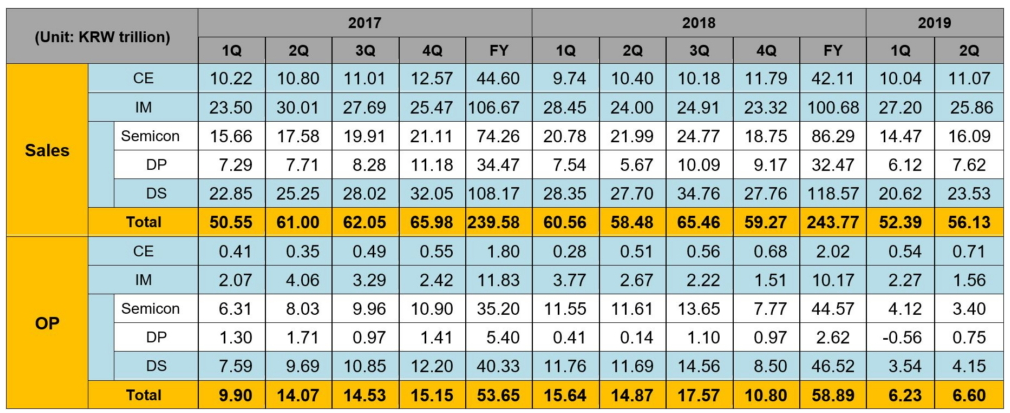Samsung Electronics today reported financial results for the second quarter ended June 30, 2019. The Company posted KRW 56.13 trillion in consolidated quarterly revenue and KRW 6.6 trillion in quarterly operating profit. The weakness and price declines in the memory chip market persisted as effects of inventory adjustments by major datacenter customers in the previous quarters continued, despite a limited recovery in demand. The Display Panel Business reported improvement due to a one-off gain in mobile displays and stronger sales of rigid OLED panels, which offset losses from large displays. The Mobile Business posted stronger shipments on new mass market models but was overall weighed down by slower sales of flagship models and increased marketing expenses. The Network Business posted solid results on the commercialization of 5G service in South Korea. The Consumer Electronics Division was boosted by strong sales of new appliance products and improved profitability of refrigerators and washing machines, although profits from TVs fell slightly YoY due to intensifying competition. Looking ahead to the second half, Samsung expects persistent uncertainties in the memory business, although demand is seen growing further on strong seasonality and adoption of higher-density products. For system semiconductors, higher demand in mobile APs, image sensors and display driver ICs (DDIs) is also expected to be seen. For displays, new smartphone product launches are set to help mobile display earnings but overall sluggish demand in the broad smartphone market may limit upside potential. As competition in the smartphone market is seen increasing in the second half, Samsung plans to enhance its product lineup and expand sales of new mass market models. The Network Business will prioritize building the foundation for its global 5G business expansion. The Consumer Electronics Division expects a seasonal boost in TV sales and will focus on premium models, while offering new appliances such as Bespoke refrigerators and AirDressers. The Company is facing challenges from uncertainties not only in business areas but also from changes in the global macroeconomic environment. Samsung will, however, continue to invest in enhancing business capabilities and future technologies, including 5G, system semiconductors, artificial intelligence and automotive components, for longer-term growth. In the second quarter, Samsung Electronics’ capital expenditure stood at KRW 6.2 trillion, including KRW 5.2 trillion spent on semiconductors and KRW 0.5 trillion on displays. Total capital expenditure in the first half was KRW 10.7 trillion, including KRW 8.8 trillion for semiconductors and KRW 0.8 trillion for displays. The main portion of the Company’s 2019 capex is earmarked for building infrastructure to address demand beyond 2019, and a larger percentage of this year’s investment will be made in the second half. Semiconductor Sees 2H Demand Recovery Amid External Uncertainties The Semiconductor Business posted consolidated revenue of KRW 16.09 trillion and operating profit of KRW 3.4 trillion for the quarter. Despite weak market conditions, the Memory Business saw demand for NAND and DRAM increase as mobile and storage applications continued to adopt higher-density products and as datacenter customers resumed purchasing. In the second half, demand is expected to grow although the Company sees volatility in the overall industry due to increased external uncertainties. For NAND, demand for high-density, high value-added datacenter and mobile storage is likely to continue to grow and the market is expected to gradually stabilize from the third quarter. In SSD, deployment of high-density, high-performance products for datacenters will expand, while demand for mobile applications is expected to increase with the release of high-end smartphones with storage of more than 128GB. The Company will focus on strengthening competitiveness in the premium market and plans to mass produce 6th generation V-NAND this year. For DRAM, overall demand is expected to increase due to seasonal effects amid external uncertainties. Server demand is expected to increase gradually as customers adjust their inventory levels and resume purchasing, while PC demand is also likely to expand. Memory demand from mobile applications is expected to show a steady increase due to the launch of new models from major customers and the trend toward high-density products. The Company plans to actively address customer demand through a flexible product mix and maintain technical leadership with the ramping up of 1Y-nm products. For the System LSI Business, earnings were solid as demand increased for multiple cameras and high-resolution, large-pixel image sensors. The Company also increased the supply of 5G chipset solutions and continued to develop a next-generation one-chip 5G System-on-Chip for future technology leadership. In the second half, demand for mobile AP, image sensor, and DDI products is expected to grow on stronger smartphone seasonality. Looking ahead, Samsung plans to increase the supply of high value-added products including 64MP image sensors and EUV 7-nm APs and also diversify product offerings by developing 3D/fingerprint-on-display sensors and chips for automotive and IoT applications. For the Foundry Business, results were robust on the back of strong demand from a major customer’s 8/10-nm mobile AP and image sensor products. In addition, new orders from customers increased in the 10/14-nm process and applications diversified to include mobile, HPC, automotive and network products. In the second half, earnings growth is expected to continue due to the ongoing expansion of orders for AP, image sensors and DDI as well as increased demand for HPCs, including crypto currency mining chips. The Company plans to start mass production of EUV 6-nm process and aims to strengthen its competitiveness through tape-out of the EUV 5-nm process and by completing 4-nm process development. 
|